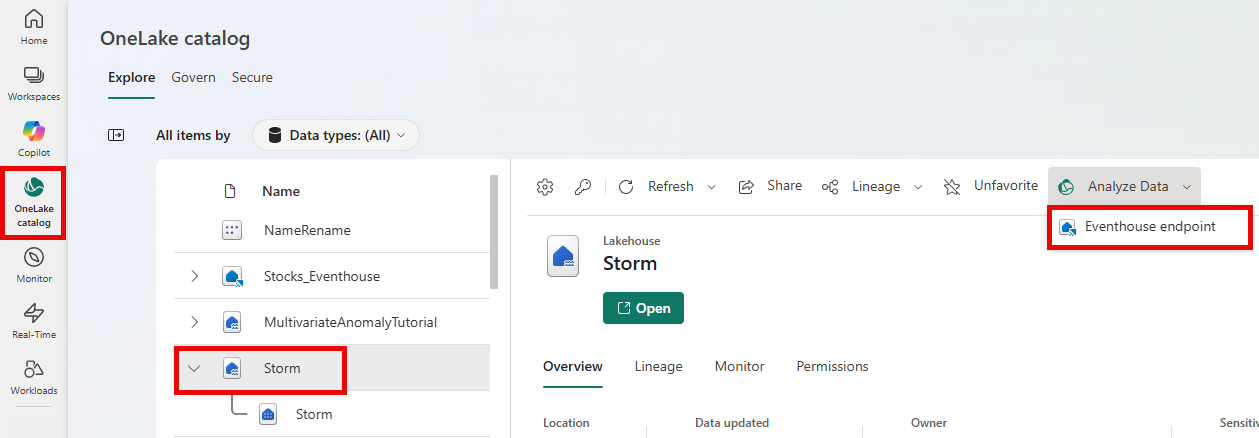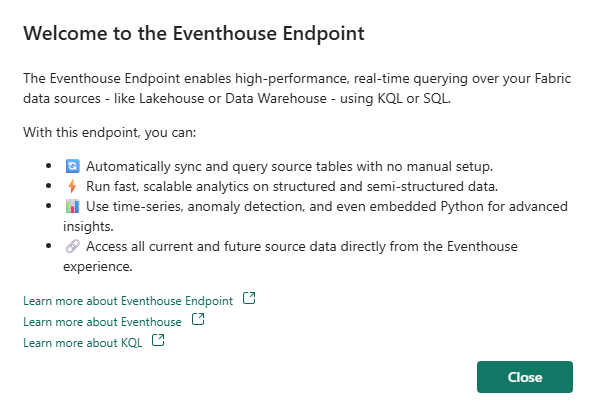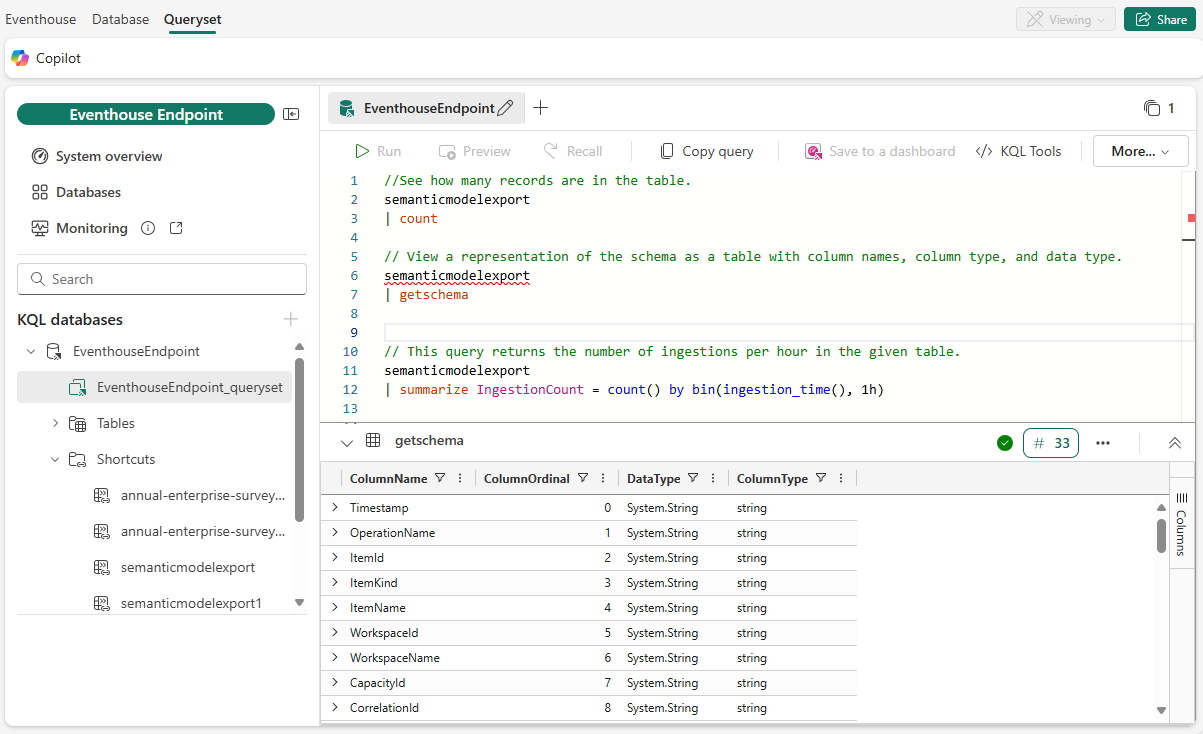Note
Access to this page requires authorization. You can try signing in or changing directories.
Access to this page requires authorization. You can try changing directories.
The Eventhouse endpoint for lakehouse is a powerful capability in Microsoft Fabric that enables users to query Lakehouse tables with exceptional speed and ease.
Use the Eventhouse endpoint to query lakehouse data, discover real-time insights across your data estate, and streamline analysis of structured, semi-structured, and unstructured data.
Benefits
Enable the Eventhouse endpoint to get:
- Instant schema sync: The endpoint syncs tables and schema changes within seconds with no manual setup. See the list of sync statuses.
- Mirrored schema: Access current and future Lakehouse data through a mirrored schema in a dedicated KQL database view.
- Rich consumption and visualization options: Use Copilot, NL2KQL, dashboards, embedded queries, and visual data exploration.
- Reflected in Workspace and OneLake catalog trees: The endpoint eventhouse and database appear as new branches in your lakehouse tree.
- Fast, scalable queries: Run analytics in KQL or SQL using advanced table operators and commands.
- Advanced insights: Run time series analysis, detect anomalies, and use Python for advanced processing.
After you enable the endpoint, it tracks the source lakehouse data and optimizes it for Eventhouse-like performance and flexibility. Each lakehouse table is attached to a OneLake shortcut in the Eventhouse endpoint with Query acceleration policies that optimize the source data.
Performance
Use the Eventhouse endpoint immediately after you create it. The first queries can run more slowly while the service caches data. Within 10 seconds, the endpoint is fully synced. As more data is cached, the query performance improves. You can check the sync status on the System Overview or Databases page, and check the status for each Shortcut. See sync statuses.
Permissions
Users with contributor or owner permission on the parent data source get contributor permission on the Eventhouse endpoint. They can manage cache and retention settings.
Sharing
To be able to share the endpoint, configure share settings for both the Eventhouse endpoint, the KQL database, and the Lakehouse source data.
Prerequisites
- A workspace in a capacity with Microsoft Fabric enabled
- A Lakehouse with tables in your workspace or in your OneLake catalog
Enable the Eventhouse endpoint
After you enable the endpoint, it appears as a child item of the Lakehouse in both the workspace and the OneLake catalog.
Select the Lakehouse you want to query. You can enable the Eventhouse endpoint from your Fabric workspace, your OneLake catalog, or from the Lakehouse ribbon.
From your Fabric Workspace, browse to the Lakehouse, and from the more options menu ... select Eventhouse endpoint.
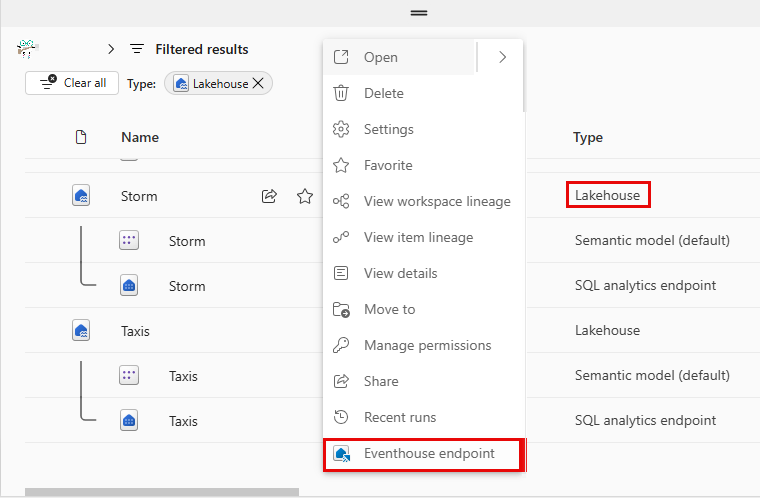
From the OneLake catalog, browse to the Lakehouse, and from the more options menu ... select Eventhouse endpoint.
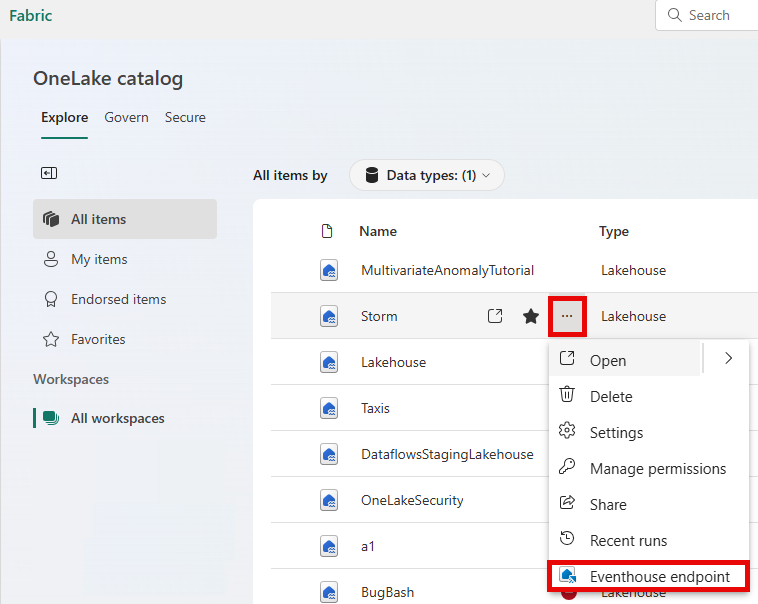
From the OneLake catalog, select the Lakehouse, and from the Lakehouse toolbar select Analyze Data > Eventhouse endpoint.
The Eventhouse Endpoint opens with a welcome message. Select Close to view and start querying the Eventhouse.
The new Eventhouse endpoint has these characteristics:
- The Eventhouse is named Eventhouse Endpoint and is read-only.
- The KQL database is named <Lakehouse_Name>_EventhouseEndpoint.
- The embedded KQL queryset is named <Lakehouse_Name>_EventhouseEndpoint_queryset.
- Shortcuts reference OneLake tables.
- Query each shortcut directly by using the table function.
- If the lakehouse has multiple schemas, the schema name shows in each shortcut name. For example, if the schemas are
salesandmarketingand each has a table namedcustomers, the shortcuts aresales_customersandmarketing_customers.
The workspace and the OneLake catalog show the endpoint and the KQL database as child items of the Lakehouse.
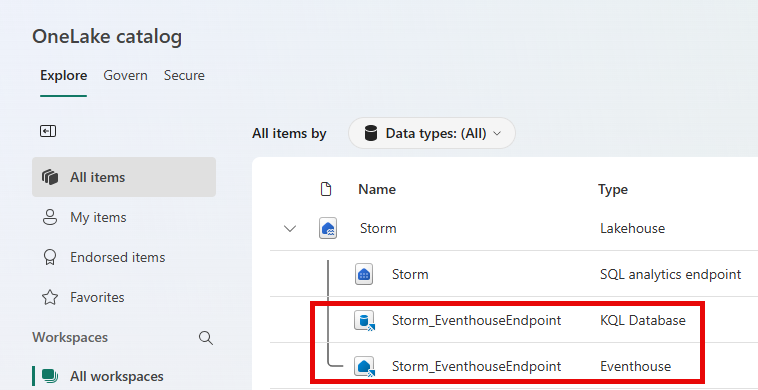
Query the Eventhouse endpoint
From the Eventhouse endpoint, run queries, create visualizations, and perform advanced analytics using KQL or SQL.
Disable the Eventhouse endpoint
Remove the Eventhouse endpoint from the workspace or the OneLake catalog. The Eventhouse endpoint and the KQL database are deleted. The Lakehouse remains unchanged.
Open the Fabric workspace.
Browse to the Eventhouse Endpoint branch of the Lakehouse tree, and from the more options menu ... select Delete.
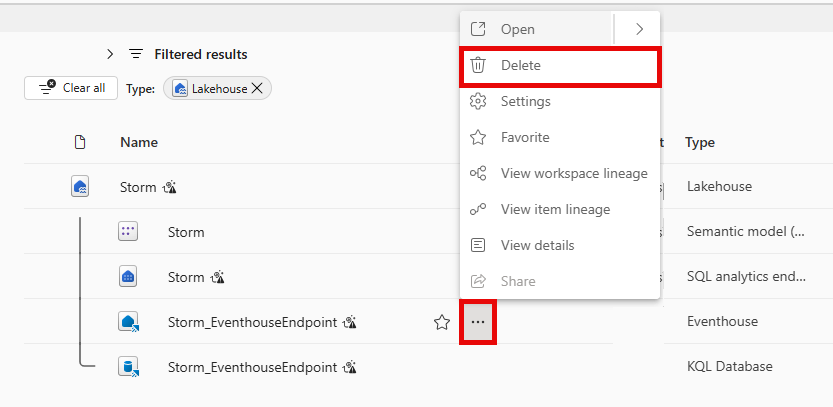
In the confirmation dialog, select Delete.
Re-enable the Eventhouse endpoint
If you delete the Eventhouse endpoint, you can re-enable it at any time. The new endpoint creates a new Eventhouse and KQL database. The new database doesn't retain any previous queries, visualizations, or dashboards. If you try to re-enable the endpoint while the previous endpoint is still being deleted, you see a message to wait a few seconds. After the previous endpoint is deleted, you can re-enable it.
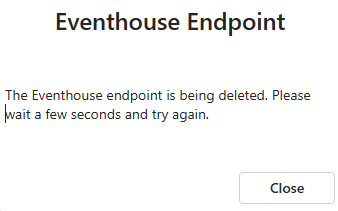
Sync statuses
The Eventhouse endpoint syncs the source Lakehouse tables and schema changes within seconds. The sync status is displayed in the System Overview and databases page, and in each table shortcut. Here's an example of a sync status:

Sync statuses for the Eventhouse endpoint:
| Sync status | Desription |
|---|---|
| synced | All OneLake shortcuts are synchronized. Source link: {link} |
| workInProgress | Synchronization in progress. ${syncing} of ${total} OneLake shortcuts are currently syncing. Some OneLake shortcuts are still warming up. Source link: {link} |
| warmingUp | Eventhouse endpoint is warming up. More than 50% of some OneLake shortcuts are warming up. The system is aligning with the source engine. Source link: {link} |
Sync statuses for shortcut:
| Sync status | Desription |
|---|---|
| synced | This shortcut is fully synchronized. Over 98% of the data is in sync with the source. Source link: {link} |
| workInProgress | Synchronization is underway. Between 20% and 98% of the data is currently synced with the source. Source link: {link} |
| warmingUp | Synchronization is in progress. Less than 20% of the data is currently synced with the source. Source link: {link} |
Considerations and limitations
- You can't currently enable the Eventhouse endpoint from within an open lakehouse.
- The System overview page of the Eventhouse endpoint doesn't show any statistics.
- Updates to the Eventhouse endpoint cache policy aren't supported
- Changing the source table schema won't be reflected at the Eventhouse endpoint.
